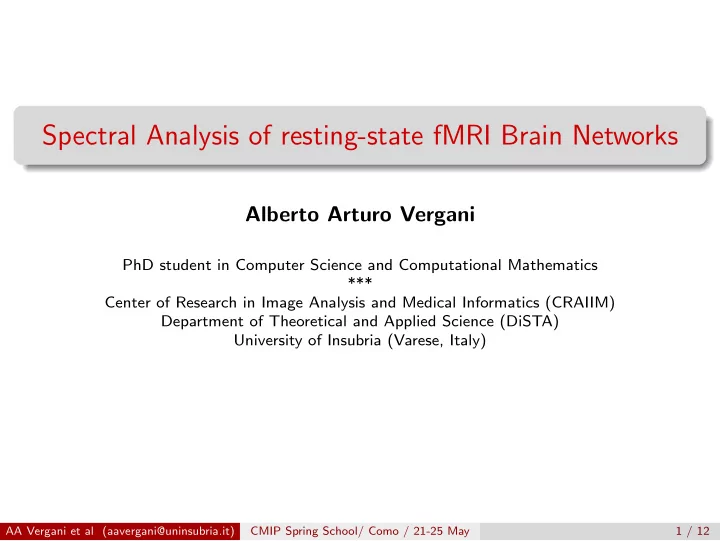

Spectral Analysis of resting-state fMRI Brain Networks Alberto Arturo Vergani PhD student in Computer Science and Computational Mathematics *** Center of Research in Image Analysis and Medical Informatics (CRAIIM) Department of Theoretical and Applied Science (DiSTA) University of Insubria (Varese, Italy) AA Vergani et al (aavergani@uninsubria.it) CMIP Spring School/ Como / 21-25 May 1 / 12
Contents The resting-state fMRI brain networks 1 The spectral analysis 2 AA Vergani et al (aavergani@uninsubria.it) CMIP Spring School/ Como / 21-25 May 2 / 12
The resting-state fMRI brain networks AA Vergani et al (aavergani@uninsubria.it) CMIP Spring School/ Como / 21-25 May 3 / 12
The resting-state fMRI brain networks Experimental Dataset: 15 Healthy subjects | 3T MRI scanner Question: are there some noise correlations? ◮ Spectral analysis of Pearson correlation matrix AA Vergani et al (aavergani@uninsubria.it) CMIP Spring School/ Como / 21-25 May 4 / 12
The spectral analysis Principal Component Analysis (PCA) : it is a method that find an orthogonal transformation that trasforms a multivariate system to new coordinated that are linearly uncorrelated (Pearson 1901, etc) PCA ⇒ Correlation Matrix to study the collective brain activity that is identified as statistical analysis of the eigenvectos, i.e. the largest eigenvalues ... Questions A : how to select the largest eigenvalues? how to include eigenvalues associated to informative eigenvectors Question B : how exclude eigenvalues associate to non-informative eigenvectors? (randomness!) ◮ Percentage of explained variance by eigenvalues (% > 70 / 80) ◮ Kaiser (eigenvalues > 1) ◮ Random Matrix theory cut-off AA Vergani et al (aavergani@uninsubria.it) CMIP Spring School/ Como / 21-25 May 5 / 12
Random Matrix Theory cut-off Marchenko-Pastur Spectral Distribution i.e. the eigenvalues density of the empirical correlation matrix for uncorrelated i.i.d. Gaussian variables 1 � ρ ( λ ) = ( λ + − λ )( λ − λ − ) 2 π r λ ◮ r = N / T = 0 , 48, i.e. N=96 ROIs and T=208 Time Points ◮ λ ± = (1 ± √ r ) 2 λ ± are the support of eigenvalues of Gaussian (uncorrelated) multivariate variables = ⇒ the formal range to include eigenvalues associated to random variables ◮ λ − = 3 . 4571 ◮ λ + = 0 . 0198 ◮ The eigenvalues greater then λ + are not random, therefore, they are associated to informative eigenvectors (and correlations) AA Vergani et al (aavergani@uninsubria.it) CMIP Spring School/ Como / 21-25 May 6 / 12
The selection of eigenvalues by formal methods AA Vergani et al (aavergani@uninsubria.it) CMIP Spring School/ Como / 21-25 May 7 / 12
The selection of eigenvalues by formal methods According to Marchenko-Pastur limits, there are (in average) 5 informative eigenvectors in the dataset that explain approximately the 90 % of variance explained AA Vergani et al (aavergani@uninsubria.it) CMIP Spring School/ Como / 21-25 May 8 / 12
Computation of the five prototype eigenvectors There are 15 subjects ⇒ compute the bootstrapped-mean to have the five prototype eigenvectors AA Vergani et al (aavergani@uninsubria.it) CMIP Spring School/ Como / 21-25 May 9 / 12
Visualization of the five prototype eigenvectors AA Vergani et al (aavergani@uninsubria.it) CMIP Spring School/ Como / 21-25 May 10 / 12
Conclusion - Why use Marchenko-Pastur Eigenvalues Distribution In Neuroscience (and in Neuroimaging) it is important to find functional brain networks, ◮ i.e. the standard model is that the human brain is intrinsically organized into anticorrelated functional networks (PNAS 2005 - seminal paper) know if correlations are informative (not random) is crucial for a correct explorative analysis of functional MRI images AA Vergani et al (aavergani@uninsubria.it) CMIP Spring School/ Como / 21-25 May 11 / 12
Conclusion - Why use Marchenko-Pastur Eigenvalues Distribution the Marchenko-Pastur Spectral Distribution is a null model based on Random Matrix Theory able to find random correlations in fMRI literature there are few papers that have used it (16) in the total fMRI works (767.000 - clustering, ICA, dual regression, etc) Thank you ;-) AA Vergani et al (aavergani@uninsubria.it) CMIP Spring School/ Como / 21-25 May 12 / 12
Recommend
More recommend